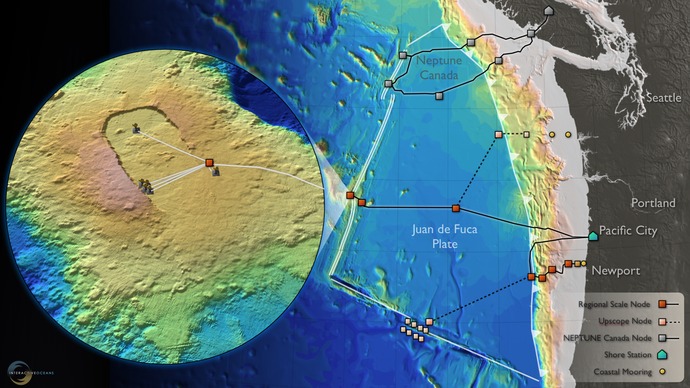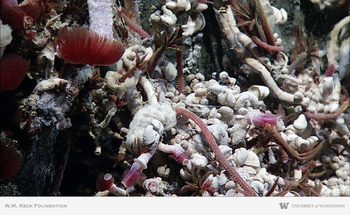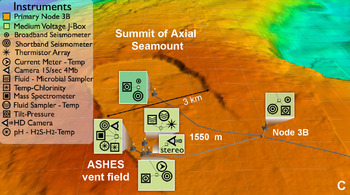Over 60% of the global volcanism occurs within the oceans.
Understanding Submarine Volcanoes
Two of the outstanding problems in marine sciences are understanding how submarine volcanoes support life in the absence of sunlight and the impact of perturbation events such as magmatic intrusion and earthquakes on geological, chemical and biological processes. Further advances in these studies are increasingly dependent on our ability to collect long-term, high-frequency observations using diverse networks of sensors and samplers. The major volcanic, magmatic and tectonic events that create the oceanic crust and modulate the fluxes of heat, chemicals and biological material across the seafloor and associated health of the biological communities are inherently episodic on decadal time scales and they are also short-lived. Transient events such as magmatic eruptions at mid-ocean ridges increase carbon dioxide output and venting volume by as much as a factor of 100, resulting in extensive microbial blooms.
A Robust Volcanic System
Axial Seamount is the most robust volcanic system on the Juan de Fuca Ridge and it is seismically, magmatically, and hydrothermally active. It is located on the Juan de Fuca spreading center and hosts three active hydrothermal fields (ASHES, CHASM, and CASTLE). Axial Seamount is one of the best-studied volcanoes along the global mid-ocean ridge. To begin to understand process linkages at mid-ocean ridge spreading centers, OOI infrastructure at Axial Seamount will include a backbone high-voltage node that hosts a full water-column mooring with profiling capabilities and a suite of core chemical and physical sensors, and a low-voltage benthic node that provides communication to the core suite of geophysical instruments.
A Cabled Observatory at Axial Seamount
As part of the OOI, high bandwidth (10 Gb/s) cables and high power (8 kw) will be utilized at the summit of Axial Seamount to communicate with and power a diverse array of sensors to monitor the inflation and deflation of the volcano during injection of magma, hydrothermal activity, and the rich biological communities at this site. Real-time stereo high definition video will provide unprecedented views of the tubeworms, crabs, and other animals at the vents. Other sensors include in situ mass spectrometers, seismometers to monitor earthquake activity, temperature and chemical probes, fluid and DNA samplers, and pressure-tilt meters. This is the largest single experiment in the global ocean focused on long-term measurements of underwater volcanoes.



